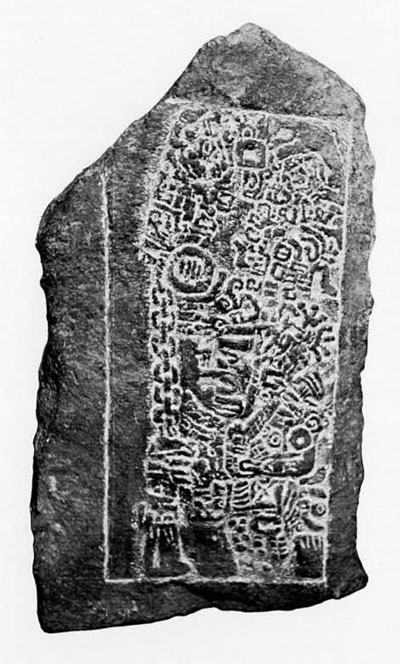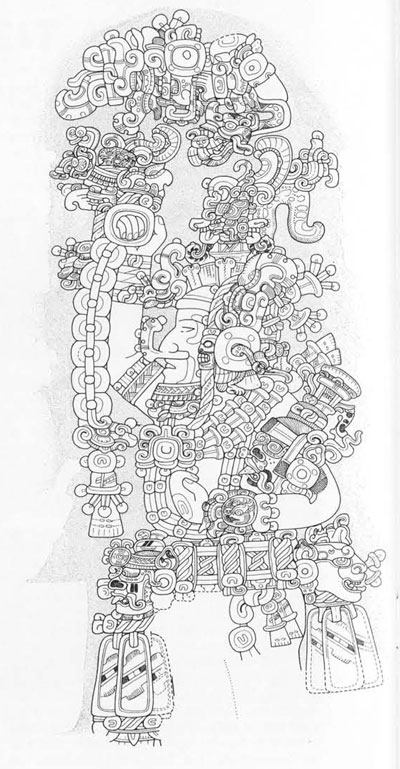
The sculptured area is not flat and does not seem to have been purposefully prepared; the surface slopes away from a low central ridge that runs the long way down the center of the stone. The basalt block, which measures 30 by 33 cm., is about 10 cm. in maximum thickness. The back is flat and unworked, The bottom edge has been broken off, but the side and top edges appear to have been trimmed with large percussion flakes; the top left corner has been broken away, perhaps to lend an air of authenticity.
At Tikal, Guatemala, over the past ten years, the University Museum’s excavations have turned up some of the most spectacular and beautiful Lowland Maya remains ever discovered. These range from vast architectural complexes and large sculptured monuments to some of the finest examples of the potter’s art, down to tiny, intricately fashioned mosaic ornaments and jade jewelry.
It was therefore inevitable that some of these choice objects, especially those which have had the most publicity, would eventually be the source of inspiration for still another flood of fakes and falsifications, which of course would wind up as valued parts of private collections or as museum donations. The only question was when and where they would first appear.
In 1965, while returning to California from field work in the Valley of Mexico, I chanced to visit the Museo de Antropologia e Historia in Tepic, Nayarit, in western Mexico, without a thought of distant Tikal in my mind.
The Tepic museum’s excellent collections of large pottery sculptures clay figurines, and stone carvings almost completely overwhelm the eye and mind. But amidst this wealth of examples of West Mexican regional styles, one object caught my attention simply because it did not fit.
The intrusive piece was a small block of dark basalt, a material not otherwise represented in the collection as far as I could see. It was carved in low relief with a design so tumultuous and complex it resembled nothing from western Mexico. On close inspection, I made out what appeared to be a chain attached to a ring that was held in a human hand.
This was enough to excite my curiosity to a high degree, because the linked chain is extremely rare anywhere in the New World south of the Arctic area. Recognition of the “chain” called to mind one of the only other examples I happened to know in Mesoamerica, and of course that was the famous Stela 31 at Tikal—this monument has a priestly figure holding what may be a series of jade discs tied together, giving him almost the appearance of an itinerant ear ornament seller.
As I looked at the Tepic museum’s little sculpture again with Stela 31 in mind, it became immediately obvious that the two were nearly identical in basic composition. Without a doubt, one was the copy of the other, or both were copies of some third sculpture.
In this case, the solution to the problem is neatly and instantaneously obvious on stylistic grounds alone.
Thus, although Stela 31 itself shows some influence from the central Mexican civilization of Teotihuacan, perhaps even recording an event of Maya contact with representatives of that culture, it is nevertheless typically Early Classic Maya in its basic style, expert craftsmanship, and long glyphic inscription. It was without doubt carved at Tikal, around A.D. 500.
The Tepic carving, on the other hand, is inexpertly done. In fact, although the carver spent much time and effort, the workmanship is sloppy and he obviously did not understand the composition he was copying nor the canons of Maya art style. Comparison with Stela 31 shows that while he included the main elements (however crudely), he confused or omitted much of the detail and filled in spaces with meaningless busywork. Since the priest’s face on Stela 31 was partially destroyed in prehistoric times, the Tepic specimen’s carver missed it entirely and may not even have realized he was copying a human figure. He seems also not to have understood the shape of the stela itself—his left-hand framing line leaves much awkward blank space, far different from what one would expect in a complex Mesoamerican art style. But the most amusing aspect of this is that the blank space is in exactly the same proportion as the shadow cast by the stela in the photograph which the carver must have used as his mode. It is interesting to speculate that because of European art traditions he may have been unconsciously predisposed to seeing the shadow as part of the composition, which would then have had more pleasing or “normal” width. His failure to think of anything to do with that blank space is a mos un-Mesoamerican attitude.
Although it is certain that the Tikal stela was the original, one may legitimately ask if the Tepic copy may not be prehistoric, a kind of portable stela brought to Nayarit; after all, a small clay stela copy was actually found at Tikal (see the article by William A. Haviland in the Spring 1962 issue of Expedition). In such a case, my interpretation of the blank shadow area would have to be wrong, and the inept copy perhaps could be attributed to an unskilled non-Maya. But the answer to this problem is also clear.

Stela 31 as presently known, is a fragment. When originally carved in the Early Classic about A.D. 500, the stela probably stood in front of a small temple on the south edge of Tikal’s North Acropolis. In the Late Classic, around A.D. 750, the stela was apparently broken (or “killed”) and the upper two-thirds fragment was therefore hidden by the new temple for over 1,200 years, until it was rediscovered by Edwin M. Shook of the Tikal Project early in 1960. When the carver made the Tepic copy, he depicted Stela 31 only down to the present broken lower edge, with the face already smashed, and did not attempt to reconstruct the bottom third of the monument.
Therefore, the Tepic copy must have been made either at about A.D. 750, in a time period that may have been only a few hours after the stela-breaking ceremony, or else sometime after the stela’s rediscovery early in 1960. The earlier date is obviously highly improbable—why copy only part of a freshly broken stela and under such circumstances? Furthermore, the early date can certainly be discarded if one gives weight to the erroneous inclusion of the stela’s shadow as part of the copy’s design.
So far, then, we have proved that the crime was committed, and when. There remain three questions: opportunity, motive, and the identify of the culprit.
The opportunity can be clearly established. Photographs of Stela 31 have been published often in the United States in Expedition and other journals, both popular and scholarly, as well as in England, Germany, Guatemala, and several times in Mexico. The most widely-distributed illustration in Mexico and the only one which includes the stela’s cast shadow was published in Life en Espanol (October 2, 1961, p.56). This is so clear that it is the ignorance of the carver that must be blamed for his poor results.
The motive cannot be demonstrated so easily as the opportunity, but it can safely be assumed to be money, which of course is the usual motive in prehistoric art faking (ego or pride of craftsmanship could hardly apply in this case). However, our knowledge of the history of the piece since it was carved is too incomplete to learn whether money changed hands.
Senorita Amparo Salazar of the Tepic museum, who very kindly aided me in photographing and studying the specimen, informed me that the carving was brought to the museum by a person from Ixtlan, who donated it. It was stated to have been found near Zacualpa, Municipo of compostela, south of Tepic. It is hard to believe that money did not change hands at some point—perhaps before the donor acquired it, some collector had purchased it, decided it was a fake, and discarded it.
The culprit is also unknown. Several colleagues who are especially familiar with the faking of industry. Perhaps it is the effort of a novice just getting into the business, in Nayarit or elsewhere. When further examples of his work turn up, the question will probably be solved.
Interest in publishing analysis of this fake goes beyond its obvious amusement value, for reasons well expressed by Godron F. Ekholm in his article “The Problem of Fakes in Pre-Columbian Art” (Curator, vol. 7, no.1, 1964). The archaeologist, the museum curator, and the artist must all be constantly on guard against fraudulent prehistoric art objects.
This illegitimate industry has been a high-volume, high-profit business for well over a century in Mexico alone. So expert are the fakers at their trade that only the most naive persons will accept at face value assurances of authenticity from the sellers of antiquities no matter what their reputation, whether sophisticated dealers or clever campesinos (it is rather like buying a luxury wristwatch at a low price in a dark alley, on the promise that it was stolen—more often than not, it turns out there is either a very cheap movement inside the case, or no mechanism at all). Positive assertions of authenticity most frequently can be traced to the self-interest of the seller, and the ego-involvement or wishful thinking of the collector.
Therefore, unless a piece was excavated by scientists under controlled conditions, the object must speak for itself—it must have inherent within it the proof of its authenticity or falsity, or forever remain in doubt as a probable fake. Falsity is the easier to demonstrate; but faking has become so expert that authenticity can rarely be proved, even though in all respects of style and workmanship the piece cannot be challenged.
In the article mentioned above, Ekholm points out how rarely “a fraud has been completely and absolutely exposed through the analysis of its design.” As one example he cites a Mexican onyx jar of excellent quality–which turned out, however, to be a proven fake when Ekholm demonstrated that the carved design had to be copied from some mural paintings over doorways at Mitla which were in their present partially destroyed condition when they were copied by the faker.
The Tepic copy of Tikal’s Stela 31 is thus another good example of a fraud exposed by the internal evidence of its own design.
One can only wonder when and where the next Tikal-inspired fake will appear—for others will surely follow. Let us hope they will be as easily detected…
